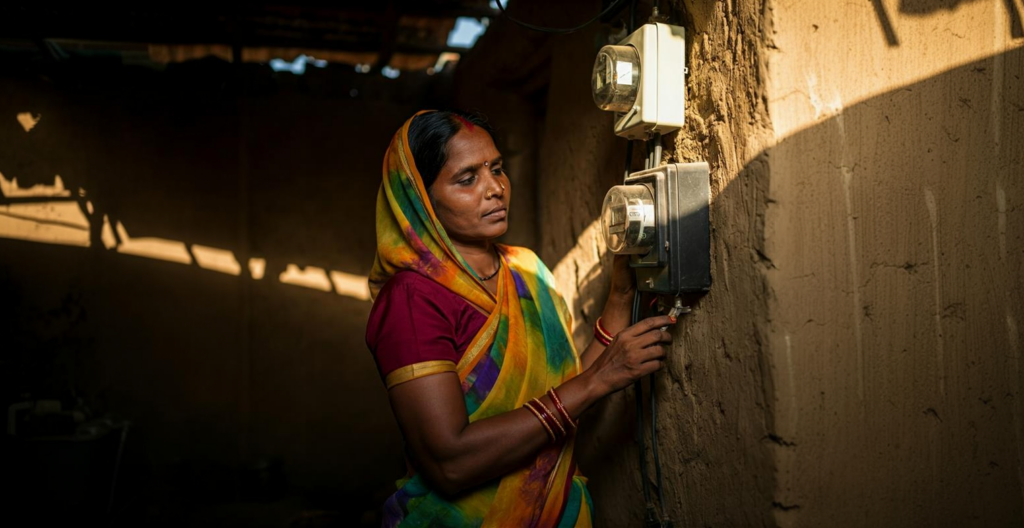Top #11 Trends in the Global Smart Metering Ecosystem to Watch for in 2025
Published on 8 January 2025

As India’s energy sector embarks on a journey of sustainability and efficiency, smart meters are taking centre stage, prepared to transform the way we consume and manage energy. They give consumers more control over their energy use, optimize grid operations, and reduce waste. They are key to improving how electricity is distributed, monitored, and consumed, creating a more transparent energy system. However, deploying smart meters in rural areas comes with its own set of challenges and opportunities. Let’s dive into these obstacles and uncover the possibilities they offer.
In order to understand the state of energy better, the Council on Energy, Environment and Water (CEEW) conducted the Indian Residential Energy Survey (IRES) 2020, across 21 Indian states, covering several dimensions of electricity. The following findings revealed a lot about India as the subcontinent continues its energy transition.

Powering Every Home: Are We There Yet?
The country has made significant progress in bringing electricity to households, with nearly 97% of homes having access to electricity in 2020, compared to just 56% in 2000. However, around 2.4% of households are still unelectrified, mainly in rural areas of northern and eastern states like Uttar Pradesh, Madhya Pradesh, Rajasthan, Haryana, and Bihar. Most of these households are multi-dimensionally poor and report that they can’t afford the cost of a grid connection.
How Steady Is the Power Supply?
Three out of four households surveyed mentioned that they continue to experience unexpected power cuts. In rural areas, two-thirds of households, and in urban areas, two-fifths, deal with daily outages. The problem is most common in Uttar Pradesh, Jharkhand, Assam, Bihar, and Haryana, where both the frequency and duration of outages are high. Additionally, one-third of households reported facing at least one of the following issues: extended blackouts, low voltage, or damage to appliances due to voltage fluctuations.
Serving a large portfolio of consumers spread out in vast territories of rural areas, providing consumers with error-free, quality, and timely bills, and simultaneously recovering the billed amount has been a major operational challenge for DISCOMs. Smart meters offer various advantages:

Accurate Billing: Traditional meters result in billing disputes. Smart meters provide precise data, reducing discrepancies.
Cost Savings in Meter Reading, Billing, Collection, and Preventing Unauthorized Electricity Use: Smart meters with prepaid functionality reduce inefficiencies in meter reading, billing, and collection processes. They enable near real-time detection of areas with losses, helping to develop strategies that prevent unauthorized electricity use. This will lead to a significant decrease in AT&C losses.
Energy Usage Control: Monitoring consumption and managing credit/debit through a consumer mobile app allows users to control and track their energy usage.
Automated Operations: Eliminating manual meter reading and bill distribution ensures objectivity, boosting operational efficiency and optimizing resources for meter reading, billing, and collection.
AI-Driven DISCOM Efficiency: DISCOMs can achieve better viability by real-time monitoring of revenue and energy management activities, reducing manual intervention, and using AI for analysing and executing targeted action plans.
Socio-Economic Impact: Effects on the State’s economy and society, including skill development, job creation, and energy savings.
Enhanced Cash Flow: Improved cash flow for distribution companies from advance payments by consumers, leading to a gradual reduction in the government’s financial burden.
Benefits of Smart Meters
| Problems | Solutions |
| Cost: An employee assigned to collect smart meter data from homes for a particular company. | With smart meters, there’s no need for an employee to collect data manually. |
| Time: Sending an employee to a consumer’s home is time-consuming. | Smart meters quickly send data to and from the server. |
| Security Issue: Traditional meters may lose consumer information at any time. | Smart meters encrypt all information and store it securely in a database. |
Infrastructure and Cost Barriers
A major hurdle to the widespread use of smart meters in India is the challenge of infrastructure and costs. The country’s large size and diverse geography, combined with an outdated electricity system needing upgrades, create significant logistical and financial difficulties.
Rolling out smart meters across such a vast area requires a considerable investment in both infrastructure and technology. Additionally, the expense of buying, installing, and maintaining these meters, especially in rural and remote locations, is a significant obstacle to their adoption.
Cybersecurity Risks in Smart Meter Deployment
Apart from infrastructure and cost issues, cybersecurity concerns are a major challenge for smart meter deployment. Since smart meters use digital networks to send data, they are exposed to cyber threats and hacking. The risk of unauthorized access to personal information and tampering with meter readings poses serious threats to both consumers and utility companies, eroding trust and confidence in the technology.
Consumer Awareness and Acceptance
Consumer awareness and acceptance are also essential for the successful rollout of smart meters. Even though smart meters offer various benefits, many people in India might not fully understand their advantages or may be sceptical of new technologies. It’s important to educate consumers about how smart meters can help and address any concerns or misunderstandings to encourage their acceptance and use.
Shortage of Skilled Technicians
A key challenge is the shortage of skilled workers for installing and maintaining smart meters. Setting up and managing these meters needs specialized knowledge and expertise in current technologies and best practices. The lack of a qualified workforce to handle and support smart meter systems makes the adoption process even more difficult.
Difficulties in Cash Payments
Most households in India still pay their electricity bills in cash at discom payment counters or through collection agents, with only 17% of billed consumers using digital payment methods—27% in urban areas and just 12% in rural areas. This is despite 70% of Indian households owning a smartphone.
The challenge this poses can be illustrated by an incident in Odisha, where a man killed an electricity meter reader over a disputed bill. Such confrontations highlight the difficulties faced by meter readers and bill collectors, who are often caught between outdated payment methods and consumer dissatisfaction. Transitioning to digital payments could help reduce these conflicts and streamline the billing process.

The Indian power story is incomplete without addressing the troubled state of electricity distribution companies, which are facing serious financial difficulties. In the 2020–21 fiscal year, over half of these public distribution companies reported aggregate technical and commercial (AT&C) losses exceeding 20%.
These high losses impact the distribution company’s ability to deliver reliable 24/7 power. A major factor contributing to their financial troubles is revenue shortfalls caused by low electricity tariffs and an inefficient billing and payment collection system, resulting in reduced recovery of electricity charges from consumers. Despite these challenges, various opportunities exist:
Government Initiatives: The Indian government’s Revamped Distribution Sector Scheme (RDSS) aims to install 250 million smart meters by 2025, focusing on rural areas.
Technological Advancements: Innovations in low-cost, durable meters designed for rural settings are emerging, potentially reducing costs.
To ensure universal and timely metering, billing, and collection, it’s crucial for discoms to adopt advanced technology and innovative approaches. While significant progress has been made in metering and regular billing, there are still some gaps. Upgrading IT infrastructure and billing systems is important, but local, context-specific solutions and incentives for key stakeholders are also needed to meet metering and billing goals. Improving collection efficiency is another challenge; offering digital payment options can help. Despite 70% of consumers having smartphones, fewer than one in five pay their bills online. To encourage more digital payments, it’s essential to develop user-friendly mobile apps in local languages, provide financial incentives, and invest in consumer education.
Community Engagement: Educating rural consumers about smart meters can significantly increase acceptance.
For instance, Sh. Sanjeev Hans, Principal Secretary of the Department of Energy in Bihar, shared that their efforts to implement smart meters faced several challenges, including building a prepaid system, managing arrears, and integrating advanced metering infrastructure (AMI) with billing systems. A key strategy to overcome these obstacles was focusing on consumer education and training DISCOM staff. He emphasized that rigorous scientific evaluation of smart metering projects, supported by organizations like EPIC and J-PAL, is crucial for success.
The journey towards smart metering in rural India is full of challenges, yet it also presents a unique opportunity for transformation. From addressing infrastructure and cost barriers to ensuring cybersecurity and consumer acceptance, the road ahead demands a collective effort from the government, industry, and consumers alike.
However, the potential rewards are immense. Smart meters can empower rural communities with greater control over their energy consumption, enable DISCOMs to operate more efficiently, and pave the way for a more sustainable and resilient power sector.
In this endeavour, companies like Kimbal are playing a crucial role. By developing innovative and cost-effective smart metering solutions tailored for India, Kimbal is helping to bridge the gap between technology and accessibility, ensuring that the benefits of smart metering reach every corner of India.

Published on 8 January 2025

Published on 5 November 2024

Published on 31 October 2024
Your email address will not be published. Required fields are marked *